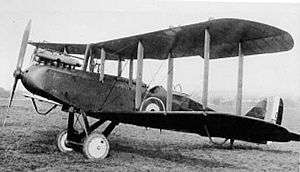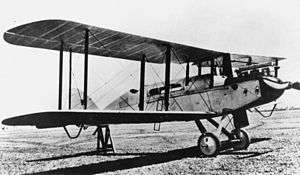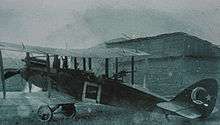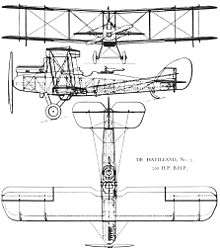Airco DH.9
| DH.9 | |
|---|---|
 | |
| Airco D.H.9 | |
| Role | Bomber |
| Manufacturer | Airco |
| Designer | Geoffrey de Havilland |
| First flight | July 1917 |
| Introduction | November 1917 |
| Retired | 1937 |
| Primary users | Royal Air Force Royal Flying Corps |
| Number built | 4,091 |
| Variants | Airco DH.9A Airco DH.9C Westland Walrus |
The Airco DH.9 (from de Havilland 9) – also known after 1920 as the de Havilland DH.9 – was a British bomber developed and deployed during the First World War.
A single-engined biplane, the DH.9 was a development of Airco's earlier and highly successful DH.4; it reused many elements of its processor, which were mated to an all-new fuselage and the BHP/Galloway Adriatic engine, which promised considerable increases in performance. Anticipating its usefulness, the type was ordered in very large numbers for Britain's Royal Flying Corps (RFC) and Royal Air Force (RAF).
Shortly upon entering service, the DH.9's performance proved to be less than satisfactory. The Adriatic engine was both unreliable and failed to provide the expected power, which gave the DH.9 poorer performance than the aircraft it had been meant to replace; the performance deficit was attributed as having been responsible for the heavy losses that it suffered during the conflict, particularly over the Western Front. However, the subsequently-developed DH.9A, which was outfitted with a more powerful and reliable American Liberty L-12 engine, .
Design and development
The DH.9 was designed by de Havilland for the Aircraft Manufacturing Company in 1916 as a successor to the DH.4. It used the wings and tail unit of the DH.4 but had a new fuselage. This enabled the pilot to sit closer to the gunner/observer and away from the engine and fuel tank. The other major change from the DH.4 was the choice of the promising new BHP/Galloway Adriatic engine, which was predicted to produce 300 hp (224 kW) and so give the new aircraft adequate performance to match enemy fighters.[1][2]
By this time, as a result of attacks by German bombers on London, the decision was made to almost double the size of the Royal Flying Corps, with most of the new squadrons planned to be equipped with bombers.[3] Based on the performance estimates for the DH.9 (which were expected to surpass those of the DH.4), and the similarity to the DH.4, which meant that it would be easy to convert production over to the new aircraft, a massive number of orders (4,630 aircraft) were placed for the type prior to the type even flying.
In July 1917, the prototype (a converted DH.4) performed its maiden flight from Hendon Aerodrome, Charing Cross, London.[1] Unfortunately, the BHP engine proved unable to reliably deliver its expected power; the engine having been de-rated to 230 hp (186 kW) in order to improve its reliability. This deficit had a drastic effect on the aircraft's performance, especially at high altitude, with it being inferior to that of the DH.4 it was supposed to replace. This meant that the DH.9 would have to fight its way through enemy fighters, which could easily catch the DH.9 where the DH.4 could avoid many of these attacks.
While attempts were made to provide the DH.9 with an adequate engine, with aircraft being fitted with the Siddeley Puma, a lightened and supposedly more powerful version of the BHP, with the Fiat A12 engine and with a 430 hp (321 kW) Napier Lion engine, these were generally unsuccessful (although the Lion-engined aircraft did set a World Altitude Record of 30,500 ft (13,900 m) on 2 January 1919[4]) and it required redesign into the DH.9A to transform the aircraft.
Operational history
To boost the rate of production, quantity orders for the DH.9 were also placed with Alliance, G & J.Weir, Short Brothers, Vulcan, Waring & Gillow and National Aircraft Factories No. 1 and No. 2.
The first deliveries were made in November 1917 to 108 Squadron RFC and it first went into combat over France in March 1918 with 6 Squadron, and by July 1918 nine squadrons operational over the Western Front were using the type.
The DH.9's performance in action over the Western Front was a disaster, with heavy losses incurred, both due to its poor performance and to engine failures, despite the prior derating of its engine. Between May and November 1918, two squadrons on the Western Front (Nos. 99 and 104) lost 54 shot down, and another 94 written off in accidents.[5] Nevertheless, on 23 August 1918 a DH9 flown by Lieutenant Arthur Rowe Spurling of 49 Squadron, with his observer, Sergeant Frank Bell, single-handedly attacked thirty Fokker D.VII fighters, downing five of them. Captain John Stevenson Stubbs managed 11 aerial victories in a DH9, including the highly unusual feat of balloon busting with one.[6]
The DH.9 was also more successful against the Turkish forces in the Middle East, where they faced less opposition, and it was used extensively for coastal patrols, to try to deter the operations of U-boats.
Following the end of the First World War, DH.9s operated by 47 Squadron and 221 Squadron were sent to southern Russia in 1919 in support of the White Russian Army of General Denikin during the Russian Civil War.[7] The last combat use by the RAF was in support of the final campaign against Mohammed Abdullah Hassan (known by the British as the "Mad Mullah") in Somalia during January–February 1920.[7] Surprisingly, production was allowed to continue after the end of the war into 1919, with the DH.9 finally going out of service with the RAF in 1920.[8]
Following the end of the First World War, large numbers of surplus DH.9s became available at low prices and the type was widely exported (including aircraft donated to Commonwealth nations as part of the Imperial Gift programme).[4]
The South African Air Force received 48 DH.9s, and used them extensively, including against the Rand Revolt in 1922. Several South African aircraft were re-engined with Bristol Jupiter radial engines as the M′pala, serving until 1937.[9]
Civilian use

Because of the large number of surplus DH.9s available after the war many were used by air transport companies. They provided a useful load carrying capability and were inexpensive. Early air services between London, Paris and Amsterdam were operated by DH.9s owned by Aircraft Transport and Travel. A number of different conversions for civil use were carried out, both by Airco and its successor, the de Havilland Aircraft Company, and by other companies such as the Aircraft Disposal Company.[10] Some radial powered DH.9Js continued in use until 1936.[11]
Variants
- DH.9 – Revised version of the DH.4 with the pilot and observer/gunner placed closer together (3,024 production aircraft built with others built in Belgium and Spain).
- DH.9A – (also referred to as the Nine-Ack) was designed for Airco by Westland Aircraft to take advantage of the 400 hp (298 kW) American Liberty L-12 engine. Apart from the new engine and slightly larger wings it was identical to the DH.9. Initially it was hoped to quickly replace the DH.9 with the new version, but the shortage of Liberty engines available to the RAF limited the new type's service in the First World War, and it is best known as a standard type in the postwar RAF, serving as a general purpose aircraft for several years. 2,300 DH.9As were built by ten different British companies.
- DH.9B – Conversions for civilian use as three-seaters (one pilot and two passengers)
- DH.9C – Conversions for civilian use as four-seaters (one pilot and three passengers)
- DH.9J – Modernised and re-engined conversions using the 385 hp (287 kW) Armstrong Siddeley Jaguar III radial engine. Used by the De Havilland School of Flying.

- DH.9J M'pala I – Re-engined conversions carried out by the South African Air Force. Powered by a 450 hp (336 kW) Bristol Jupiter VI radial piston engine.
- M'pala II – Re-engined conversions carried out by the South African Air Force, powered by a 480 hp (358 kW) Bristol Jupiter VIII radial piston engine.
- Mantis – Re-engined conversions carried out by the South African Air Force, powered by a 200 hp (149 kW) Wolseley Viper piston engine.
- Handley Page HP.17 – A DH.9 experimentally fitted with slotted wings, tested 1920-1.[12]
- USD-9/9A – DH.9s manufactured in the United States by the US Army's Engineering Division and Dayton-Wright. (1,415 ordered, only four built)[13]
Operators
Military operators

- Afghan Air Force – 18 aircraft, including 16 built by Duks Aircraft Works, acquired from 1924.
- Royal Australian Air Force – One used by the RAAF from 1920 to 1929.
- No. 1 Flying Training School RAAF
- Belgian Air Force – 18 aircraft.[14]
- Chilean Air Force – Received 20.[4]
- Estonian Air Force operated 13 from 1919 to 1933 .[15]
(Part of Imperial Gift)

 Kingdom of Hejaz
Kingdom of Hejaz- The Kingdom of Hejaz received 9 DH.9s and 2 DH.9Cs between 1921 and 1924. Five remained in existence (although not airworthy) in 1932.[17]
 Ireland
Ireland
- Irish Air Service
- Irish Air Corps
- Royal Netherlands East Indies Army Air Force – operated 36, some of which were re-engined with Pratt & Whitney Wasp radial engine withdrawn in 1934.[16]
- Royal New Zealand Air Force – Three Airco DH.9s in service with the New Zealand Permanent Air Force from 1923 to 1929 as advanced training aircraft.
- Polish Air Force – 20 received in 1920, used during the Polish-Soviet war, until 1929.[18]
- South African Air Force – Part of the Imperial Gift. Some locally modified with Jupiter engines and named Mpala.

- Turkish Air Force – four aircraft, in service from 1921 to 1924.
Civil operators
- Cia Espanola del Trafico Aereo
Surviving aircraft

Of the thousands of DH.9s built, only a few have survived to be preserved. F1258 is displayed at the Musée de l'Air et de l'Espace in Paris,[19] with a second DH.9 being preserved at the South African National Museum of Military History,[20] while G-EAQM, the first single-engined aircraft to fly from the United Kingdom to Australia is preserved in the Australian War Memorial at Canberra.[21][22]
The remains of three DH.9s were discovered in India in 2000,[23] one of which is displayed at the Imperial War Museum Duxford, and another in the process of being restored to flying condition.[24]
Specifications (D.H.9 (Puma Engine))

Data from The British Bomber since 1914[8]
General characteristics
- Crew: two
- Length: 30 ft 5 in (9.27 m)
- Wingspan: 42 ft 4⅝ in (12.92 m)
- Height: 11 ft 3½ in (3.44 m)
- Wing area: 434 ft² (40.3 m²)
- Empty weight: 2,360 lb (1,014 kg)
- Max. takeoff weight: 3,790 lb (1,723 kg)
- Powerplant: 1 × Armstrong Siddeley Puma piston engine, 230 hp (172 kW)
Performance
- Maximum speed: 98 kn (113 mph, 182 km/h)
- Endurance: 4½ hours
- Service ceiling: 15,500 ft (4,730 m)
- Climb to 10,000 ft: 18 min 30 sec
Armament
- Guns: Forward firing Vickers machine gun and 1 or 2 × Rear Lewis guns on scarff ring
- Bombs: Up to 460 lb (209 kg) bombs
See also
- Related development
- Aircraft of comparable role, configuration and era
References
Notes
- 1 2 Jackson 1987, p. 97.
- ↑ Bruce 1965, p. 3.
- ↑ Bruce 2 April 1956, p. 387.
- 1 2 3 Jackson 1987, p. 100.
- ↑ Mason 1994, p. 84.
- ↑ "John Stevenson Stubbs" theaerodrome.com, Retrieved: 1 May 2011.
- 1 2 Bruce 13 April 1956, p. 424.
- 1 2 Mason 1994, p. 86.
- ↑ Jackson 1987, p. 102.
- ↑ Jackson 1973, p. 50-52.
- ↑ Jackson 1973, p. 56.
- ↑ Barnes 1976, pp. 211–213.
- ↑ "From Huffman Prairie To The Moon, The History of Wright-Patterson Air force Base" (PDF). WADC/WADD Digital Collection at the Galvin Library, IIT. 1986. pp. 184–186. ISBN 978-0160022043. Archived from the original (PDF) on 20 February 2016.
Plans called for the Curtiss Aeroplane and Moto Corporation of Buffalo, New York, to manufacture 4,000 USD-9As. The order was cancelled, however, when Allied victories in France during the summer of 1918 forecast Germany's ultimate defeat...at least four USD-9A airplanes were manufactured at McCook, but none were built by a contractor.
- ↑ Bruce 13 April 1956, p. 423.
- ↑ Gerdessen 1982, p. 76.
- 1 2 Bruce 13 April 1956, p. 425.
- ↑ Andersson Air Enthusiast July/August 2004, pp. 39–42.
- ↑ Kopański, Tomasz Jan. Samoloty brytyjskie w lotnictwie polskim 1918–1930 (British aircraft in the Polish air force 1918–1930). Bellona, Warsaw. 2001, ISBN 83-11-09315-6, pp. 55–62. (in Polish)
- ↑ "DH.9." Musée de l'Air et de l'Espace. Retrieved: 11 April 2008.
- ↑ Blake, Arthur."Colours in the Sky." Military History Journal, Vol 1, No 6. June 1970. The South African Military History Society. Retrieved: 11 April 2008.
- ↑ Jackson 1987, p. 125.
- ↑ "AWM Collection Record: P02270.029." Australian War Memorial, Retrieved: 11 April 2008.
- ↑ "In pictures: 'Elephant stable' bomber." BBC News, 21 April 2007. Retrieved: 11 April 2008.
- ↑ "DH-9." Historic Aircraft Collection Ltd, Retrieved: 11 April 2008.
Bibliography
- Andersson, Lennart. "Wings Over the Desert: Aviation on the Arabian Peninsula: Part One Saudi Arabia". Air Enthusiast, No. 112, July/August 2004. pp. 39–43. ISSN 0143-5450.
- Barnes, C.H. Handley Page Aircraft since 1907. London:Putnam, 1976. ISBN 0-370-00030-7.
- Bruce, J. M. "Aircraft Profile No. 62: The de Havilland D.H.9". Profile Publications Ltd, 1965.
- Bruce, J.M. "The De Havilland D.H.9: Historic Military Aircraft: No. 12, Part I". Flight, 6 April 1956. Pages 385–388, 392.
- Bruce, J.M. "The De Havilland D.H.9: Historic Military Aircraft: No. 12, Part II". Flight, 13 April 1956. Pages 422–426.
- Gerdessen, F. "Estonian Air Power 1918 – 1945". Air Enthusiast No 18, April – July 1982. Pages 61–76. ISSN 0143-5450.
- Jackson, A.J. British Civil Aircraft since 1919 Volume 2. London:Putnam, Second edition 1973. ISBN 0-370-10010-7.
- Jackson, A.J. De Havilland Aircraft since 1909. London: Putnam, Third edition 1987. ISBN 0-85177-802-X.
- Mason, Francis K. The British Bomber Since 1914. London: Putnam Aeronautical Books, 1994. ISBN 0-85177-861-5.
- Winchester, Jim, ed. Bombers of the 20th Century. London: Airlife Publishing Ltd., 2003. ISBN 1-84037-386-5.
External links
| Wikimedia Commons has media related to Airco DH.9. |
- DH9 at Imperial War Museum, Duxford
- AAirco D.H.9 – British Aircraft Directory